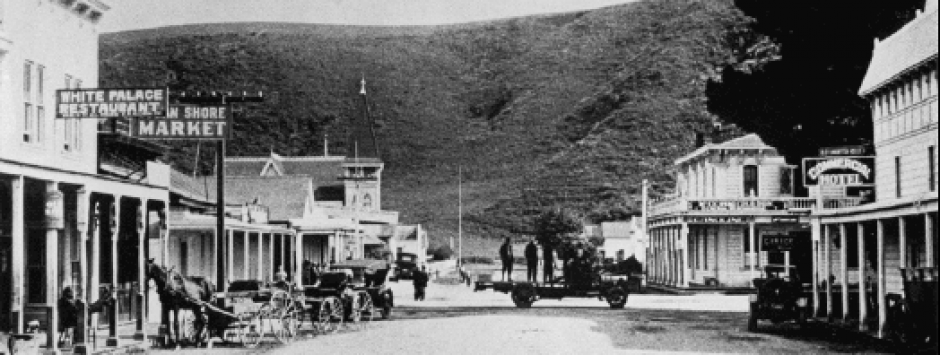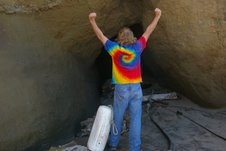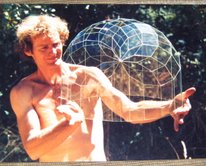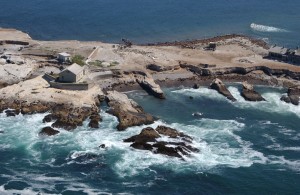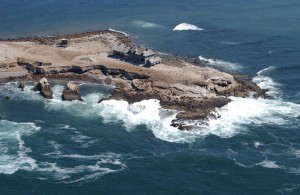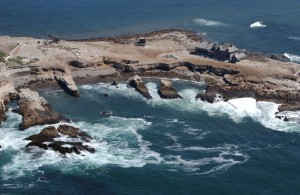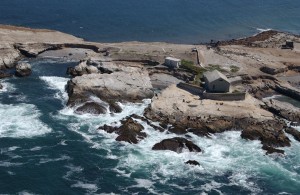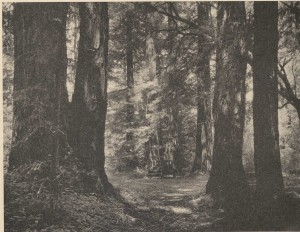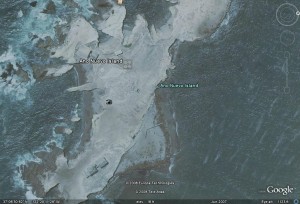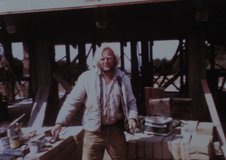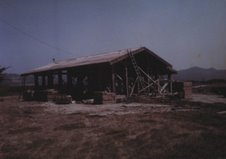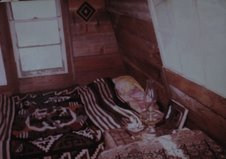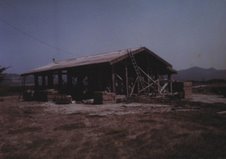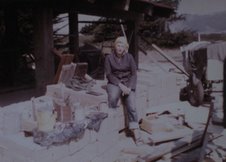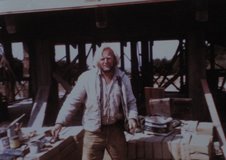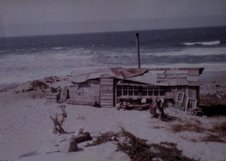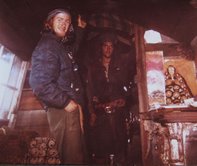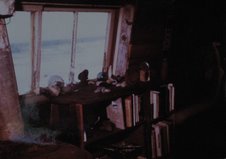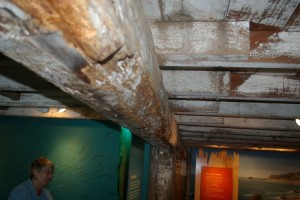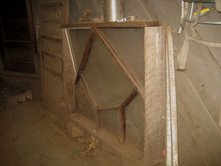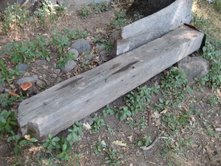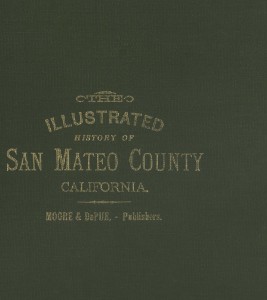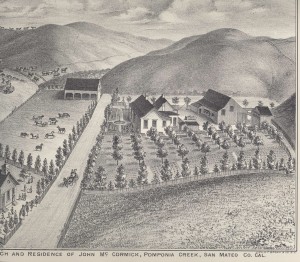Story by Russell Towle
email Russell ([email protected])
June, another recollection or two from my days at Año Nuevo Point, 1970-72.
Of Winds and Whales
The prevailing west winds of temperate latitudes are most often
northwest winds, along the Central California coast. At Año Nuevo
these northwest winds were strong and cold. The belt of cold upwelling
water which exists up and down the coast has to swing wide away from
Año Nuevo because of the Island. This cold water rises from depth and
brings nutrients with it, hence the robust fishery off the California
coast. It also chills the moist oceanic air mass below the dew point,
hence our fog. At times atmospheric conditions were such that clear
skies existed above the Point itself, but a mass of fog stood just
offshore, and from that fog gusted the Eternal Wind.
The only thing which stops that northwest wind is a cyclonic storm,
with its southerly or southwest winds. In summer the cyclonic storms
stay well to the north, and the fair-weather-regime northwest wind
howls, night and day, for weeks on end, without relief.
It is a horrible horrible thing. The farther one is from the beach,
the better, so far as that horrible horrible, damp, bone-chilling wind
is concerned. Hence all the old ranches are tucked up against the base
of the mountains, about as far from the beach as could reasonably be
managed. I myself lived eight feet or less from the beach. There was
no escape. It meant sweaters and jackets and scarves and wool hats all
summer long. And driftwood fires in my wood stove.
So close to the beach, the salt air quickly rusted away my galvanized
six-inch-diameter stove pipes. Once upon a time, with my stove pipe in
ruins, I spotted a badly-dented aluminum pipe along the margin of the
artichoke fields nearby. I felt it would harm no one to liberate this
ten-foot length of six-inch aluminum pipe, and soon I had a new stove
pipe.
One single length, too; what could be better than that?
All went well for a couple of months. One summer day Bigfoot and I
were shivering on the beach, and it seemed good to retreat to my
cabin, with armloads of driftwood, and to build a very good fire, and
then to pack one of Bigfoot’s magical little soapstone pipes with
certain excellent herbs, and bid defiance to the Eternal Wind.
Bigfoot, I should say, was tall and thin and deeply tanned, with
little bones and feathers and trinkets hanging here and there all
about his person, a wild bush of sun-gilded dark hair up on top, and
classic aquiline features. If he had not been a quasi-African Shaman,
he might have passed for an Italian Prince.
I was a regular expert at building fires. I prided myself upon my
fires. On this day, the wind so bitter, the sun itself shrouded in a
dismal and bitter fog, the driftwood itself damp from that Eternal
Wind, and wishing to dispel all this in favor of warmth, in favor of
an all-embracing warmth which would send even the merest ghosts of
coldness fleeing in desperation, I built the fire up rather nicely.
Too nicely, as it turned out.
I packed that stove with driftwood and opened all dampers.
Bigfoot and I relaxed in front of the stove in my tiny cabin, seated
on a wooden platform with some rotten foam padding it, and an Indian
blanket from Oaxaca hiding the truth of the matter, and we passed his
tiny pipe back and forth, gradually shedding jackets and sweaters. The
fire roared. We smoked. It roared. The stove pipe turned a little red.
It can happen. We smoked. A sense of peace and well-being settled upon
us. A lack of anxiety. A keen enjoyment of thundering waves, an actual
appreciation of funereal fog, a love of sand dunes and flowering bush
lupine and music; all this was felt.
Sitting there, I remarked to Bigfoot, “Look there, Bigfoot, how very
strange: it is as though you can see the flames inside the stove
pipe!”
The stove roared. We gazed at the stovepipe. It was red. But there was
a flickering to that redness, as though one could see flames right
through the metal. Right through the aluminum.
Then, in a sudden shock, we realized we actually could see flames
right through the stove pipe. In the space of seconds we realized that
all that remained of my aluminum stove pipe, for a distance of two or
three feet above the stove, was a thin film, that tenuous something
which is left when 99% of the metal is melted, vaporized, or whatever.
In those few seconds, that last transparent film itself disappeared,
and we were faced with flames blowtorching up from my stove into my
cabin.
We ran out into my kitchen area, with its sand floor, grabbed a bucket
and an empty pot, made some running leaps down onto the beach, and
dipped up ocean water. Then we charged back. The redwood paneling I
had added to the inside of the walls and ceiling was on fire; we threw
one bunch of water into the stove, another on the burning redwood, and
ran and jumped back for more. In a few minutes we had it out.
This was a depressing thing. However, we retreated to Bigfoot’s cabin
and packed up the pipe again. We got a fire going in his stove, and
all was well.
Some years later I was spending the summer at Año Nuevo, living in the
Big House built for Janet and Merrill, who had moved back to Los Altos
while work proceeded on their new place in Pescadero. That horrible
horrible wind never let up. It happened that a kite was in the house.
I should mention that in 1970 I had hit upon the idea of taking curved
lengths of bull kelp, which had dried hard on the beach, and by
cutting them off at a suitable point, and opening a hole in the “bell”
of the kelp, I could make a nice horn, blown like a trumpet, from
which several notes could be sounded. I called them Kelphorns, and
sometimes we had five or ten around. They were a lot of fun. One could
pick out elaborately curved lengths of bull kelp and make a horn six
feet long.
I got the kite up in the air, up into that northwest wind, and started
paying out string. I had a big roll of string and soon the kite was a
quarter-mile away. I tied it off to one of the porch posts, and days
later it was still flying strong.
I began to wonder just how strong that wind could be. The Eternal Wind
was beginning to surprise even me. I reeled the kite back in most all
the way, and started tying Kelphorns to the string. Was the Eternal
Wind up to the task of lifting a Kelphorn?
It was. That cruel wind laughed at the task, and lifted kite and
Kelphorn high. I tied a second, third, and fourth Kelphorn to the
string, about ten yards apart from one another, and paid out my
quarter-mile of string again.
It was a noble thing to see those Kelphorns floating in air over the
sand dunes to the south. The string at that distance was entirely
invisible. I tied it off to the porch post again, and watched my
Flying Kelphorns for two weeks straight. Finally the Eternal Wind
abated just enough to let the horns drop down into the dunes.
It did not stop, it only lessened.
Oh, we became unwilling students and connoisseurs of the winds of Año
Nuevo. Only rarely was it ever truly still, and even then, the ocean
swell rarely diminished. The principal direction in which the swells
move is northwest to southeast, but a strong cyclonic storm, or series
of cyclonic storms, and set up a southwest well. If the winds are
rarely still there, how much more rarely is the ocean ever still.
While staying at Año Nuevo Island one winter day, with a single
researcher, I noticed that the ocean had calmed remarkably. It was not
“flat as a mill-pond,” but the swell was much diminished. The Island
causes wave refraction, and a curious situation obtains in the Channel
between the Point and the Island: waves come into the Channel from
both sides, from northwest and from southwest.
This made for a somewhat perilous crossing on the Zodiac raft the
scientists used. Waves would come at the raft from left and from
right. They would collide into little mountains of water.
On this day, though, even the Channel seemed calm. I went to the
researcher, and pointed out how amazingly calm the ocean was, and
suggested we take the Zodiac out, for a turn around the Island.
We did so. Almost immediately we discovered that even when the ocean
seems calm, and the swells, small, to actually be out there on those
small swells is, well, dramatic. We were being heaved and tossed all
over the place. After about five minutes we both deemed it an exercise
in foolhardiness and turned back to the safety of the shore.
On another winter’s day, the wind was mysteriously still, the air
mysteriously warm, and the ocean was actually as flat as a mill-pond.
I have never seen the like. A weak cyclonic storm had brought no rain,
only a south wind for several days running, which had damped down that
northwest swell. It had erased it. I was on the beach at dawn and
within an hour or so had shed all my clothes. It was such a blessing,
a warm day at Año Nuevo.
Gone, the sweaters, gone the heavy coats, gone the scarves and hats.
Looking out over the mystery-sea, gleaming with color, iridescent like
an abalone shell, it came to me that the canoe up at the Greenhouse
would be a wonderful thing to have at the beach. I began to run and
scamper though the dunes. I met Bigfoot wandering seaward with an
amazed expression on his face, and in a few minutes of excited
exhortation, convinced him to help me carry the canoe down to the
beach.
We carried it that quarter-mile or so, and walked directly into the
ocean, set the canoe down, stepped calmly in, and began paddling.
There were no waves to worry about. We struck out west and soon the
beach was far behind us. Beds of kelp appeared, each with a horde of
sea-birds resting upon it. We continued west, going from kelp bed to
kelp bed, and scaring clouds of white birds into the air.
The Island was now well astern to our left, and we could see from
Pescadero to Santa Cruz. A final kelp bed, a final horde of white
birds, stood farther out to sea, and we made for it. I’d say we were
over two miles from shore. Just as we neared our Ultima Kelp, three
Gray Whales breached the surface a few yards in front of us, expelling
spray from their blowholes, and turning their eyes upon us.
All of a sudden I realized we were miles from shore, without life
vests or anything of the sort, in a flimsy, flimsy canoe. We were
stark naked but that was not the issue. Three whales fifty feet or
less from our canoe was the issue. Bigfoot and I oohed and ahed and
then he began paddling again. Towards the whales. I emitted a choked
scream and began paddling backwards very very strongly.
“Bigfoot, what are you doing!” I shrieked.
“I want to see the whales!!!” answered Bigfoot.
Every stroke of his paddle was answered with an equal and opposite
stroke of my own. We spun in a circle, and drew no closer to the
whales.
He finally desisted in trying to paddle right up to the whales. In a
minute they sank below the surface and were gone. We saw no more kelp
to the west, and were becoming sunburned anyway. So we made for the
shore, but took a detour towards the Island, getting a good look at it
and at the Channel, where a complex of reefs was visible underwater,
for, along with the complete stilling of the wind, the complete
damping of the swell, along with that came a settling-out of sand and
clay suspended in the water. We could see urchins and starfish quite
clearly twenty feet underwater. It was quite amazing.
Such was one of my best days at Año Nuevo Point.
Russell Towle
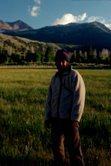 Story by Mike Merritt, Butano State Park Seasonal Interpreter
Story by Mike Merritt, Butano State Park Seasonal Interpreter